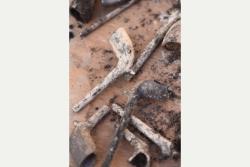INSTITUT SUPERIEUR D'ANTHROPOLOGIE
INSTITUTE OF ANTHROPOLOGY
ONLINE COURSES / COURS A DISTANCE
WINTER TERM : JANUARY 2016
REGISTER NOW
ROYAUME UNI –  Bath - A clay pipe factory dating back to the 18th century has been found intact underground in Bath. Archaeologists excavating an area in Sawclose discovered dozens of tobacco pipes inscribed with workers' initials. They found two five-and-a-half foot kilns among a series of other production rooms while preparing the site ahead of a planned £19 million casino, hotel and restaurant complex. It is believed the factory operated between around 1780 and 1860 – before cigarettes were invented.
Bath - A clay pipe factory dating back to the 18th century has been found intact underground in Bath. Archaeologists excavating an area in Sawclose discovered dozens of tobacco pipes inscribed with workers' initials. They found two five-and-a-half foot kilns among a series of other production rooms while preparing the site ahead of a planned £19 million casino, hotel and restaurant complex. It is believed the factory operated between around 1780 and 1860 – before cigarettes were invented.
http://www.bathchronicle.co.uk/Holy-smokes-Clay-pipe-factory-intact-Sawclose/story-28042197-detail/story.html
USA – Bristol - Countless artifacts are buried throughout western New York as remnants of Native Americans and Europeans who once lived there. Hardly any of it ever gets unearthed for research, but in Bristol, Ontario County, a treasure trove of findings shed light on the area’s ancestors. A property called “Burning Springs” on Bristol’s Case Road — named for the flammable gas which bubbles up through a stream on the property — is known as an ancient spiritual location for Native Americans and a settlement of some of town’s first pioneers. Archaeologists only recently began an excavation of the site, and found pounds of material dating back hundreds of years. Objects found include cookware and housing items, coins, glass and Native American projectile points, which could have been used for arrows or spears. There were at least three homesteads on the property throughout the 18th and 19th centuries as settlers moved into the area from other places in the colonial U.S. Before that, it was populated by members of the Seneca Nation of Indians.
http://www.democratandchronicle.com/story/news/2015/10/23/burning-springs-archaeology-native-americans-artifacts/74419580/
USA –  Kincaid Mounds - The earliest dates of activity at the Kincaid Mounds in Massac County, Illinois, go back to 1050 A.D. It was once a large village, the capital of a Native American chiefdom, which existed until 1400 A.D., says John Schwegman of the Kincaid Mounds Support Organization. The Kincaid Mounds were once a walled city, where a chiefdom ruled over farming (primarily corn) villages sprawling 10 miles in different directions. The large mounds rise 30 feet and on them platforms exist today where buildings once sat. In past digs, they've identified a chief's house, council house and a temple that had a perpetual fire. The University of Chicago purchased the mounds in the 1930s and conducted large excavations. Their first big find was discovering who made the mounds. This dig changed the way we think about pre-Columbian civilization in North America. At the time, people thought the mounds were too technically advanced for Native Americans to have built and that it had to be some lost race of people that came before, Schwegman says. But their civilization had collapsed because of the disease Cortez brought into Mexico and spread into North America, he adds, anywhere where there were dense populations, people died of smallpox and influenza.Many famous archaeologists throughout the 20th century did their first dig at this site, he says, and a large volume of the dig was eventually published. Though large in scale, the excavations never found the sweat lodges where men would sit and 'sweat out the demons.' SIU found several of those in more recent years, and through carbon dating are able to identify more clearly the years of activity. The mounds are located east of Brookport, Illinois, just north of the Ohio River.
Kincaid Mounds - The earliest dates of activity at the Kincaid Mounds in Massac County, Illinois, go back to 1050 A.D. It was once a large village, the capital of a Native American chiefdom, which existed until 1400 A.D., says John Schwegman of the Kincaid Mounds Support Organization. The Kincaid Mounds were once a walled city, where a chiefdom ruled over farming (primarily corn) villages sprawling 10 miles in different directions. The large mounds rise 30 feet and on them platforms exist today where buildings once sat. In past digs, they've identified a chief's house, council house and a temple that had a perpetual fire. The University of Chicago purchased the mounds in the 1930s and conducted large excavations. Their first big find was discovering who made the mounds. This dig changed the way we think about pre-Columbian civilization in North America. At the time, people thought the mounds were too technically advanced for Native Americans to have built and that it had to be some lost race of people that came before, Schwegman says. But their civilization had collapsed because of the disease Cortez brought into Mexico and spread into North America, he adds, anywhere where there were dense populations, people died of smallpox and influenza.Many famous archaeologists throughout the 20th century did their first dig at this site, he says, and a large volume of the dig was eventually published. Though large in scale, the excavations never found the sweat lodges where men would sit and 'sweat out the demons.' SIU found several of those in more recent years, and through carbon dating are able to identify more clearly the years of activity. The mounds are located east of Brookport, Illinois, just north of the Ohio River.
http://wkms.org/post/audio-see-recent-kincaid-mounds-excavations-archaeology-field-day-saturday#stream/0